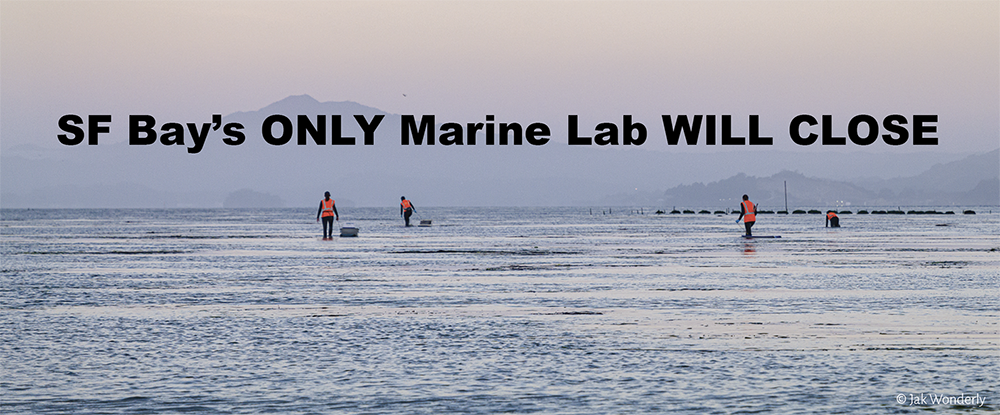The Estuary & Ocean Science Center, the only marine science laboratory on San Francisco Bay, is slated to close.
Located in Marin County on the Romberg Tiburon Campus of San Francisco State University, the EOS Center relies on funding from SFSU, which now faces severe budget shortfalls. SFSU can no longer, on its own, support the EOS Center, and has recommended imminent closure. Sustained financial support is critical to ensure a marine research and training center uniquely positioned to confront California’s climate crisis, especially in SF Bay and its communities.
What can you do?
$5M over four years would keep the Center open and operations going as a long-term solution is developed.
- Please reach out to Interim Executive Director, Dr. Kathy Boyer, if you can help with philanthropy: katboyer@sfsu.edu.
- Please consider a donation to help keep the EOS Center open as we work toward the longer-term solution.
- Spread the word, tell your networks, friends and family why you care about the EOS Center.
- Visit Friends of the Estuary & Ocean Science Center, a volunteer group of scientists, conservationists, history buffs, climate warriors, and concerned citizens working together to keep the Center open. Fill out their survey to show support.
- Find your CA representative and tell them why it's important that the EOS Center remains open.
- Consider writing to the CSU Chancellor about the importance of this asset and its critical impact on science education and research. Use the template below:
Why is it important that the EOS Center remains open?
- The EOS Center attracts our region’s future environmental leaders and conducts vital applied research on the health, functioning, and future of SF Bay’s ecological resources.
- Its researchers are on the cutting edge of climate change adaptation research, having contributed for decades to designing, implementing, and monitoring “living shorelines” projects in the Bay, and continue to advance these approaches for the region.
- More than 30 graduate students conduct research with both tenured and adjunct faculty, the latter of whom will lose the opportunity to do their critical work if the EOS Center closes. These EOS Center faculty specialize in hands-on undergraduate courses that provide skills and understanding of critical Bay ecosystems.
- The Center houses the SF Bay National Estuarine Research Reserve and the Smithsonian Environmental Research Center West -- integral to research and student mentoring at the Center and leaders in science and restoration in the Bay.
- The Center’s annual Marine Lab Open House attracts more than 700 community members each year to learn about science and conservation of the Bay.
- Closure will terminate several vital, ongoing initiatives and new collaborations before their benefits can be realized.
- A new Regional Climate Science Consortium is using the bayside location to evaluate coastal adaptation solutions to rising sea levels and other consequences of climate change.
- A Nature-based Solutions Educational Pathways program is working with 10 community colleges to provide skills toward further education and job placement in CA’s green workforce.
- All major eelgrass restoration projects in SF Bay rely on the Center’s water system and tanks, and 75 acres are targeted in Richardson Bay in the next few years.
- A long-term, continuous water quality monitoring program contributes real-time data to a state-wide network, and helps to predict changes in SF Bay conditions, including those related to harmful algal blooms.
- A new restaurant oyster shell recycling program with Hog Island restaurants would begin collecting shell for shoreline reefs this summer, with an educational program connecting food and restoration for 250,000 restaurant patrons per year.
- The CA Department of Fish and Wildlife conducts chinook salmon releases on the site, where the deep, cool water supports survival of smolts.
- A NOAA grant for $5.8M to build an Aquatic Research and Training facility must be returned if the Center closes.
What is the Estuary & Ocean Science Center?
The EOS Center is a vibrant bayside hub for training, discovery, and innovation, fostering ecosystem and human resilience in the face of climate change. As the only marine lab on the shores of SF Bay since its launch 45 years ago, the EOS Center exerts an outsized impact on evidence-based decision making for the State of California through cutting-edge applied science and placement of our graduates into positions at regulatory and natural resources agencies. Onsite partnerships with the SF Bay National Estuarine Research Reserve (one of 30 nationwide reserves) and the Smithsonian Environmental Research Center enhance our research capabilities, student training, and community engagement.
Previously, the site supported a Miwok fishing camp, a US Navy base, and NOAA’s National Marine Fisheries Service, uses that took advantage of the natural deep-water port. Today the location provides quick access to Bay research in small boats, water quality monitoring for a regional/national network (CeNCOOS), and a supply of baywater that permits controlled experiments to simulate the current and future conditions of SF Bay. A mile of shoreline allows testing of nature-based approaches to mitigate climate change impacts.
Contact: Dr. Kathy Boyer, Interim Executive Director and Professor of Biology, katboyer@sfsu.edu
If you have other contacts at the EOS Center, NERR, or SERC, please feel free to reach out.
